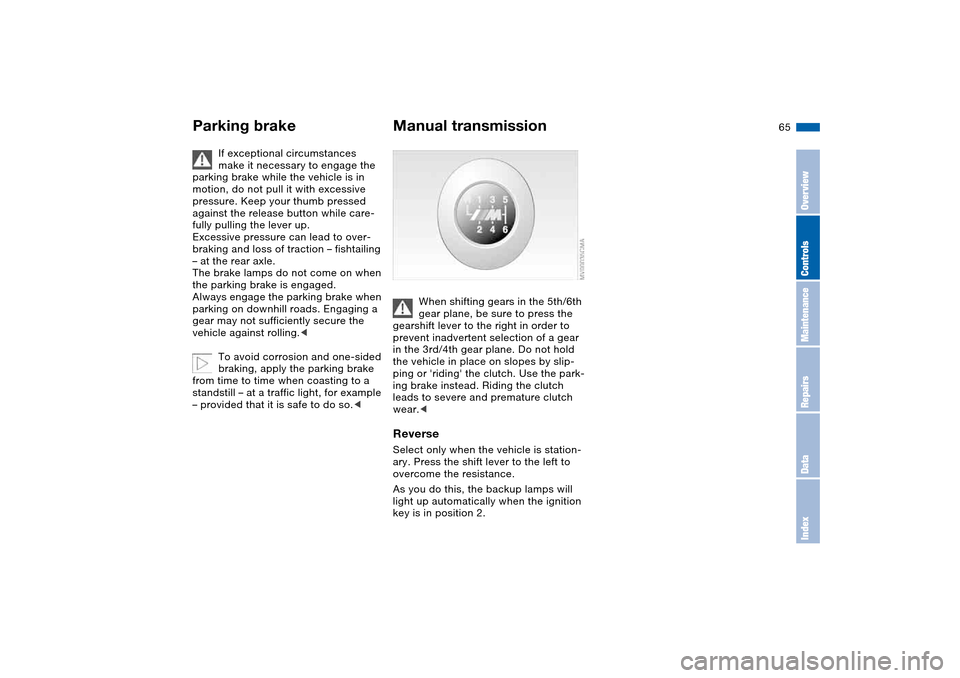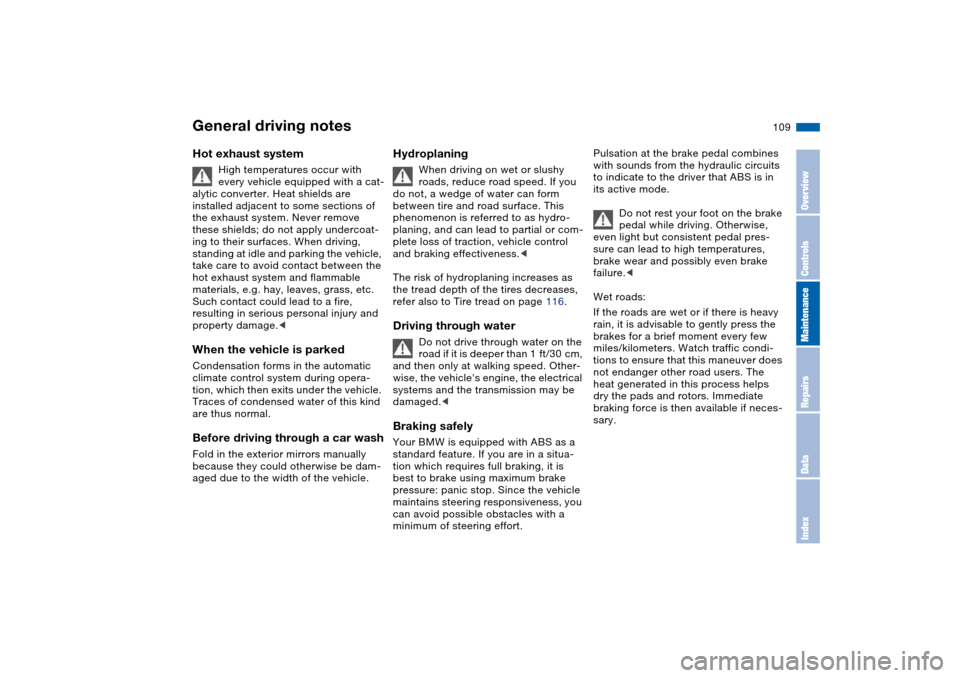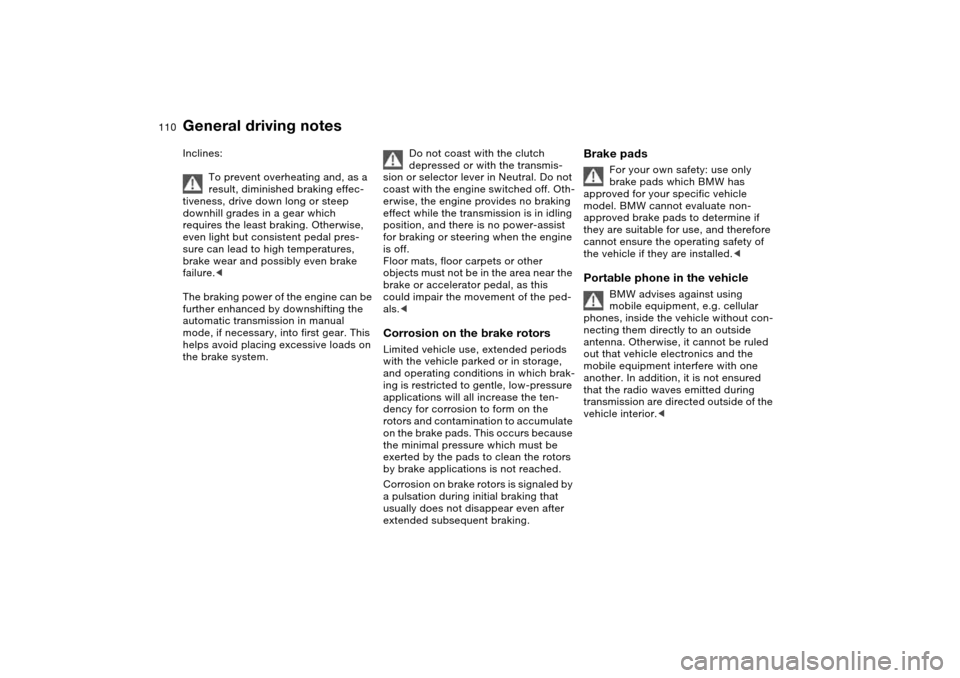2006 BMW M3 COUPE automatic transmission
[x] Cancel search: automatic transmissionPage 9 of 170

Contents
9
Driving:
Ignition lock61
Starting the engine and driving
off62
Switching off the engine64
Parking brake64
Manual transmission65
Sequential M gearbox with
Drivelogic*66
Turn signal indicator/Headlamp
flasher71
Washer/wiper system/Rain
sensor*72
Cruise control*73
Everything under control:
Odometer75
Tachometer75
Engine oil temperature75
Fuel gauge76
Engine coolant temperature
gauge76
Service interval display77
Check Control77
Clock78
Computer79
Technology for safety and
driving convenience:
Park Distance Control (PDC)*81
Dynamic Stability Control
(DSC)82
Flat Tire Monitor83
M Engine dynamics control85
Brake force display86
Lamps:
Parking lamps/Low beams87
Instrument lighting88
High beams/Standing lamps88
Front fog lamps89
Interior lamps89
Controlling the climate for
pleasant driving:
Automatic climate control90
Roller sun blind*94
Interior conveniences:
Premium sound system*95
Glove compartment95
Storage compartments96
Microphone*97
Ashtray, front*98
Ashtray, rear*98
Clothes hooks99
Loading and transporting:
Through-loading system100
Ski bag*101
Cargo loading102
Roof-mounted luggage
rack*105
Controls and features
Page 64 of 170

64
Switching off the engine
You should never remove the igni-
tion key when the vehicle is in
motion, as the steering lock could
engage.
When you leave the vehicle, always
remove the ignition key and engage the
steering lock.<
Always engage the parking brake
when parking on downhill roads.
Engaging a gear may not sufficiently
secure the vehicle against rolling.<
Manual transmissionTurn the ignition key to position 1 or 0.Sequential M gearbox with
DrivelogicIf you turn the ignition key to position 1
or 0 with the selector lever in the for-
ward or reverse position, a gear auto-
matically remains engaged.
If you turn the ignition key to position 1
or 0 with the selector lever in position
N, a warning tone and the flashing gear
indicator in the SMG Drivelogic display
remind you that no gear is engaged to
secure the vehicle against rolling.
The warning stops after approx.
10 seconds. If you move the selector
lever into a forward or reverse position
during this time, a gear is automatically
engaged.
Parking brakeThe parking brake is designed primarily
to prevent the vehicle from rolling when
it is parked. It operates against the rear
wheels.To engageThe detent engages automatically, and
the indicator lamp in the instrument
cluster comes on when the ignition key
is in position 2, refer to page 18.To releasePull up slightly on the lever, press the
button and lower the lever.
Page 65 of 170

65
If exceptional circumstances
make it necessary to engage the
parking brake while the vehicle is in
motion, do not pull it with excessive
pressure. Keep your thumb pressed
against the release button while care-
fully pulling the lever up.
Excessive pressure can lead to over-
braking and loss of traction – fishtailing
– at the rear axle.
The brake lamps do not come on when
the parking brake is engaged.
Always engage the parking brake when
parking on downhill roads. Engaging a
gear may not sufficiently secure the
vehicle against rolling.<
To avoid corrosion and one-sided
braking, apply the parking brake
from time to time when coasting to a
standstill – at a traffic light, for example
– provided that it is safe to do so.<
Manual transmission
When shifting gears in the 5th/6th
gear plane, be sure to press the
gearshift lever to the right in order to
prevent inadvertent selection of a gear
in the 3rd/4th gear plane. Do not hold
the vehicle in place on slopes by slip-
ping or 'riding' the clutch. Use the park-
ing brake instead. Riding the clutch
leads to severe and premature clutch
wear.<
ReverseSelect only when the vehicle is station-
ary. Press the shift lever to the left to
overcome the resistance.
As you do this, the backup lamps will
light up automatically when the ignition
key is in position 2.
Parking brake
OverviewControlsMaintenanceRepairsDataIndex
Page 109 of 170

109
General driving notesHot exhaust system
High temperatures occur with
every vehicle equipped with a cat-
alytic converter. Heat shields are
installed adjacent to some sections of
the exhaust system. Never remove
these shields; do not apply undercoat-
ing to their surfaces. When driving,
standing at idle and parking the vehicle,
take care to avoid contact between the
hot exhaust system and flammable
materials, e.g. hay, leaves, grass, etc.
Such contact could lead to a fire,
resulting in serious personal injury and
property damage.<
When the vehicle is parkedCondensation forms in the automatic
climate control system during opera-
tion, which then exits under the vehicle.
Traces of condensed water of this kind
are thus normal.Before driving through a car washFold in the exterior mirrors manually
because they could otherwise be dam-
aged due to the width of the vehicle.
Hydroplaning
When driving on wet or slushy
roads, reduce road speed. If you
do not, a wedge of water can form
between tire and road surface. This
phenomenon is referred to as hydro-
planing, and can lead to partial or com-
plete loss of traction, vehicle control
and braking effectiveness.<
The risk of hydroplaning increases as
the tread depth of the tires decreases,
refer also to Tire tread on page 116.
Driving through water
Do not drive through water on the
road if it is deeper than 1 ft/30 cm,
and then only at walking speed. Other-
wise, the vehicle's engine, the electrical
systems and the transmission may be
damaged.<
Braking safelyYour BMW is equipped with ABS as a
standard feature. If you are in a situa-
tion which requires full braking, it is
best to brake using maximum brake
pressure: panic stop. Since the vehicle
maintains steering responsiveness, you
can avoid possible obstacles with a
minimum of steering effort.
Pulsation at the brake pedal combines
with sounds from the hydraulic circuits
to indicate to the driver that ABS is in
its active mode.
Do not rest your foot on the brake
pedal while driving. Otherwise,
even light but consistent pedal pres-
sure can lead to high temperatures,
brake wear and possibly even brake
failure.<
Wet roads:
If the roads are wet or if there is heavy
rain, it is advisable to gently press the
brakes for a brief moment every few
miles/kilometers. Watch traffic condi-
tions to ensure that this maneuver does
not endanger other road users. The
heat generated in this process helps
dry the pads and rotors. Immediate
braking force is then available if neces-
sary.
OverviewControlsMaintenanceRepairsDataIndex
Page 110 of 170

110
Inclines:
To prevent overheating and, as a
result, diminished braking effec-
tiveness, drive down long or steep
downhill grades in a gear which
requires the least braking. Otherwise,
even light but consistent pedal pres-
sure can lead to high temperatures,
brake wear and possibly even brake
failure.<
The braking power of the engine can be
further enhanced by downshifting the
automatic transmission in manual
mode, if necessary, into first gear. This
helps avoid placing excessive loads on
the brake system.
Do not coast with the clutch
depressed or with the transmis-
sion or selector lever in Neutral. Do not
coast with the engine switched off. Oth-
erwise, the engine provides no braking
effect while the transmission is in idling
position, and there is no power-assist
for braking or steering when the engine
is off.
Floor mats, floor carpets or other
objects must not be in the area near the
brake or accelerator pedal, as this
could impair the movement of the ped-
als.<
Corrosion on the brake rotorsLimited vehicle use, extended periods
with the vehicle parked or in storage,
and operating conditions in which brak-
ing is restricted to gentle, low-pressure
applications will all increase the ten-
dency for corrosion to form on the
rotors and contamination to accumulate
on the brake pads. This occurs because
the minimal pressure which must be
exerted by the pads to clean the rotors
by brake applications is not reached.
Corrosion on brake rotors is signaled by
a pulsation during initial braking that
usually does not disappear even after
extended subsequent braking.
Brake pads
For your own safety: use only
brake pads which BMW has
approved for your specific vehicle
model. BMW cannot evaluate non-
approved brake pads to determine if
they are suitable for use, and therefore
cannot ensure the operating safety of
the vehicle if they are installed.<
Portable phone in the vehicle
BMW advises against using
mobile equipment, e.g. cellular
phones, inside the vehicle without con-
necting them directly to an outside
antenna. Otherwise, it cannot be ruled
out that vehicle electronics and the
mobile equipment interfere with one
another. In addition, it is not ensured
that the radio waves emitted during
transmission are directed outside of the
vehicle interior.<
General driving notes
Page 160 of 170

Everything from A to ZGearbox
manual transmission 65
Gearbox malfunction
sequential M gearbox with
Drivelogic 70
Gearbox, sequential 66
Gearshift lever
manual transmission 65
sequential M gearbox with
Drivelogic 66
General driving notes 109
Glass sunroof
closing following an elec-
trical malfunction 41
convenience operation
30, 32
remote control 29, 30
Glass sunroof, electric 40
Glove compartment 95
Gradient assistance 69
Grills, refer to Ventilation 90
Gross weight, refer to
Weights 152
H
Handbrake, refer to Parking
brake 64
Hands-free system 97
Harman Kardon premium
sound system 95
Hazard warning flashers 14
Hazard warning triangle 23Head airbags 52
Head restraints 45
Headlamp cleaning system
cleaning headlamps 73
washer fluid 122, 153
Headlamp control 87
Headlamp flasher 88
indicator lamp 21
Headlamps
bulb replacement 133
care, refer to the Caring
for your vehicle brochure
Heated mirror 50
Heated rear window
automatic climate
control 93
Heated seats 49
Heating
exterior mirrors 50
rear window 93
seats 49
Heating and ventilation 90
Heavy loads, refer to Cargo
loading 103
Height adjustment
seats 44
steering wheel 51
Height, refer to
Dimensions 151High beams 71, 88
bulb replacement 133
headlamp flasher 88
indicator lamp 21
Holder for
beverages 96, 97
litter bag 97
Hood release 119
Horn 14
Hydraulic brake assistant,
refer to DBC 111
Hydroplaning 109
I
Ice warning 79
Ignition 61
Ignition key 28
positions 61
Ignition lock 61
Imprint 4
Indicator lamps 18Indicator/warning lamp
airbags 18
alarm system 38
brakes 18, 19
Check Gas Cap 19
coolant 19, 76
DSC 19
Flat Tire Monitor
18, 19, 85
fog lamps 20
Please fasten safety
belts 18
reserve 76
Service Engine Soon 19
Individual air distribution 92
Individual settings, refer to
Vehicle Memory, Key
Memory 59
Inflation pressure monitor-
ing, refer to Flat Tire Moni-
tor 83
Inflation pressure, tires 112
INSPECTION 77
Instrument cluster 16
Instrument lighting 88
Instrument panel 14
Interface socket for onboard
diagnostics (OBD) 128
event data recorders 128
Interior lamps 89
remote control 30
Page 161 of 170

Everything from A to Z
161
Interior motion sensor 37, 38
switching off 30, 38
Interior rearview mirror
automatic dimming
feature 50
Interior temperature
adjusting 92
Intermittent mode, wipers 72
Interval display, service 77
J
Jump-starting 143
K
Key Memory 59
Keys 28
with remote control 28
L
Lamp defect 133
Lamps and bulbs 133
Lashing down loads, refer to
Cargo loading 102
Lashing eyelets, refer to
Securing cargo 104
Lashing fittings, refer to
Securing cargo 104
LATCH child-restraint
mounting system 57
Leather care, refer to the
Caring for your vehicle
brochureLeaving the vehicle 64
LEDs light-emitting
diodes 136
Length, refer to
Dimensions 151
License plate lamp
bulb replacement 136
Light switch 87
Light-emitting diodes
(LEDs) 136
Lighter 98
LIGHTS ON warning 87
Lights, refer to Parking
lamps/Low beams 87
Litter bag holders 97
Load, determining the maxi-
mum 102
Load, refer to Cargo
loading 102
Loading
vehicle 102
Load-securing devices 104
Lock buttons on doors, refer
to Locking 33
Lock, steering wheel 61
Locking
from inside 33
from outside 29, 32
Locking and unlocking
doors
from inside 33
from outside 29, 32Low beams 87
automatic 87
bulb replacement 133
indicator lamp, defective
lamp 77
Luggage compartment
capacity 152
emergency operation,
refer to Manual
operation 34
floor mat 37
floor panel 36
lid 34
opening from outside 34
opening, remote
control 30
opening/closing, refer to
Luggage compartment
lid 34
remote control 30
volume 152
Luggage compartment lid 34
emergency operation 34
emergency release 36
indicator lamp 77
opening from inside the
vehicle 34, 35
opening from outside 34
remote control 30
securing separately 34
unlocking manually 34Luggage compartment light-
ing 34
Luggage rack, refer to Roof-
mounted luggage rack 105
Lumbar support 44
M
M Engine dynamics
control 85
M Mobility system 137
M Track mode 82
indicator lamp 20
Maintenance 77, 126
Maintenance system 126
Making telephone calls,
refer to the telephone
Owner's Manual
Malfunction
door lock 32
fuel filler door 24
Malfunction displays 77
Manual operation
door lock 32
driver's door 32
fuel filler door 24
glass sunroof 41
luggage compartment
lid 34
Manual transmission 65
Master keys
with remote control 28
OverviewControlsMaintenanceRepairsDataIndex
Page 163 of 170

Everything from A to Z
163
Power socket, cigarette
lighter 98
Pressure monitoring, tires
Flat Tire Monitor 83
Pressure, tires 112
inflating with M Mobility
system 139
Proposition 65 warning 6
Puncture
M Mobility system 137
R
Radio remote control key,
refer to Master key with
remote control 28
Radio, refer to the Owner's
Manual for Radio
Rain sensor 72
Range 80
Reading lamps
front 89
rear 89
Rear armrest, refer to Rear
center armrest 97
Rear backrest, folding 100
Rear center 3-point safety
belt 100
Rear lamps
bulb replacement 135
indicator lamp, defective
lamp 77Rear window heating
automatic climate
control 93
Rear-entry assist 46
Rearview mirror 50
Receiving assistance 142
Recirculated-air mode
automatic climate
control 93
Recirculating the air, refer to
Recirculated-air mode 93
Reclining seat, refer to Seat
adjustment 44
Refueling 24
fuel filler door 24
Releasing
hood 119
Remaining distance to ser-
vice 77
Remaining distance, refer to
Range 80
Remote control 29
luggage compartment
lid 30
malfunction 30
Replacing lamps, refer to
Lamps and bulbs 133
Reporting safety defects 7
Restraint systems
for children 55
Restraint systems, refer to
Safety belts 46Reverse gear
manual transmission 65
Roof load capacity 152
Roof-mounted luggage
rack 105
Rope, refer to Towing
and tow-starting the vehi-
cle 145
S
Safe seating position 42
airbags 42
safety belt 42
Safety belt
safe seating position 42
Safety belt height adjust-
ment 47
Safety belts 46
height adjustment 47
warning lamp 18
Safety feature
glass sunroof 40
power windows 39
Safety systems, refer to
Antilock Brake
System 111
Dynamic Stability Control
(DSC) 82
Screwdriver, refer to
Onboard tool kit 132Seat adjustment
backrest width adjust-
ment 45
BMW sports seat 44
height 43
lumbar support 44
manual 43
power 44
Seat belt tensioner, refer to
Safety belts 46
Seat heating 49
Seat memory, refer to Seat
and mirror memory 48
Seat positions, storing 48
Seats 43
Securing cargo 104
Securing child-restraint sys-
tem 57
Securing the vehicle
from inside 33
from outside 29, 32
Selector lever
sequential M gearbox with
Drivelogic 66
Selector lever positions
sequential M gearbox with
Drivelogic 66
Sequential M gearbox with
Drivelogic 66
indicator lamp 19, 70
tow-starting 146
OverviewControlsMaintenanceRepairsDataIndex